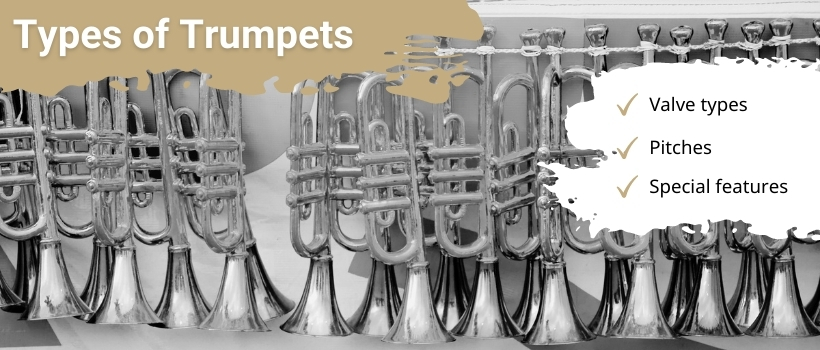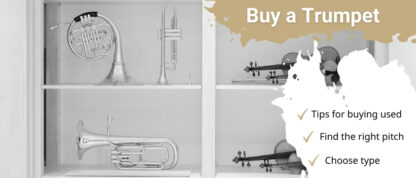
The trumpet is probably one of the most popular brass instruments. From classical to rock music, it is represented in all musical genres. What is special about it is that it is a lip-sounding instrument. This means that the vibration that produces the sound is generated by the lips. The player thus becomes part of the instrument. This distinguishes the trumpet from many other wind instruments where, for example, like the saxophone, a wooden reed is set in vibration to produce the sound. The range depends on the player and is between three and four octaves. We show you what types of trumpets there are.
The difference between the rotary valve trumpet and the pump valve trumpet
A basic distinction is made between 2 types of trumpets: The rotary valve trumpet, also called the German trumpet, and the pump valve trumpet, called the Périnet trumpet. The differences relate to the valves and also affect the sound of the trumpet. The rest of the construction, however, is the same.
The rotary valve trumpet
The rotary valve trumpet is also called the German trumpet. It is mainly used in Germany, Austria and Switzerland. It is particularly popular in the field of symphonic music.
As the name suggests, the notes on this trumpet are regulated by rotary valves. Physically, the rotary valves have the same effect as pump valves: the air path is changed and thus also the resulting tone. The difference lies in the mechanics. When the pushers are actuated, the movement is transferred to a rotary valve. This is then opened and the air flow is directed through the valve arch. If all the valves are not actuated, the natural tone series of the instrument is heard. It is produced by the player’s blowing technique.
In addition to the valves, the German trumpet can also be recognised by its shorter leadpipe and larger bell. Overall, it sounds somewhat fuller than its French counterpart. It is therefore particularly suitable for orchestral use.
The Pump Valve Trumpet

The pump valve trumpet, also called the Périnet trumpet, was originally developed in France. Today it has become established worldwide. It is used not only for jazz, but also for classical pieces and traditional wind music. The valves of the Périnet trumpet are simpler than those of the German trumpet. When the trigger is pressed, the valves are pushed down, giving the air stream more room. This type of valve leaves more room for effects such as the glissando.
The Périnet trumpet is also recognisable by its smaller bell and longer mouthpiece. This makes the response of this trumpet easier. Overall, the sound is somewhat less full-bodied.
The keys: All the types of trumpets at a glance
Both the German trumpet and the Périnet trumpet are further divided into the different keys. There are the following types of rotary valve trumpets and pump valve trumpets:
| Type | c1 sounds as | Noted pitch range |
| Piccolo trumpet | B/A, G/F, Es/D, Hoch-C | fis – c”’ |
| Bb trumpet | B | as – e |
| C trumpet | C | as – fis |
| D trumpet | D | as – gis |
| Eb trumpet | Es | fis – c”’ |
| bass trumpet | B, C, D, Es | as – B1 |
The piccolo trumpet
The highest registers can be reached particularly well by the piccolo trumpet, as its range begins at d’ and is open towards the top according to the skill of the player. The piccolo trumpet is most commonly used in the Bb/A tuning. Here, tuning is possible in both Bb and A. This is done by changing the mouthpipes. These can be replaced by longer or shorter ones and thus produce higher or lower notes. However, they also exist in G/F, E-flat, E-flat/D or high-C tuning, although they are much less common.
Unlike other types of trumpets in Bb or higher registers, the piccolo has a fourth valve to facilitate intonation and fingering. The sound is naturally somewhat more pointed and thinner than on a full-bodied Bb trumpet and is therefore less suitable for jazz music, but all the better for signal passages in classical pieces.
The piccolo trumpet is usually tuned in Bb/A. However, there are also piccolo trumpets tuned in G/F, Eb, Eb/D or high C.
The Bb trumpet
A good model for trumpet beginners is the Bb trumpet. It transposes, as the name suggests, a major second lower to a Bb. The instrument has the standard size that one directly associates with the instrument and comes to a total tube length of approximately 134cm. It is not to be confused with a bass trumpet, which can also be tuned in Bb, but is considerably larger.
On the Bb trumpet, a C played sounds a large second lower than Bb.
A C trumpet
The C trumpet is the only one that does not transpose, but where the audible notes correspond exactly to the fingered notes. In terms of size, it is very similar to the Bb trumpet, the only difference being its somewhat brighter sound. It is sometimes used in orchestral passages that would be more difficult to play on a Bb trumpet. Otherwise, however, it offers no advantages to the beginner.
The C trumpet does not transpose. A fingered C is sounded as C as well.
The D and E flat trumpet
Both the D and E-flat trumpets are smaller than their B-flat counterparts, which is why they sound brighter. The D trumpet transposes up a second, the E-flat trumpet plays a third higher. To support the intonation of the high registers, E-flat trumpets often have a fourth valve. Both pitches are often used for high passages in the orchestra.
The D trumpet is tuned in D, a fingered C sounds as one second higher than D. On the E-flat trumpet, on the other hand, the C sounds a third higher than E-flat.
The bass trumpet
The bass trumpet is not found very often because the instrument is very large and, at about 2 kg, also quite heavy. It is therefore used more in classical ensembles or in military music. The instrument is about 60cm long, but has a winding tube length of up to 2.60m.
This makes it sound much deeper than its smaller relatives, but still brighter than a trombone, for example. It is usually tuned to Bb, but is also available in C, D and Eb.
The bass trumpet is available in Bb, C, D and Eb tuning.
The natural trumpet
The natural trumpet is characterised by the fact that it has no valves. It can only play the natural notes, i.e. the notes that the player can produce by different types of embouchure measured by the length of the tube. Natural trumpets have been used since ancient times. In the Middle Ages they were mainly used for military purposes. They were only replaced when the valve for wind instruments was invented in 1815. This made it possible to produce chromatic scales.
FAQ: What you need to know about all types of trumpets
The range of a trumpet depends on the player. Professional trumpet players can play 3 to 4 octaves.
There are basically two types of trumpet: The German or rotary valve trumpet and the Périnet or pump valve trumpet. Both variants are available in the tunings Bb, C, D, Eb, Bass and as a piccolo trumpet.
Not all trumpets are tuned in Bb, there are also D or Eb trumpets, for example. The Bb tuning has merely turned out to be the most popular among trumpets.
Trumpets usually have three valves. Rarely they also have 4 valves. This makes the sound more voluminous and more fingerings can be combined.










